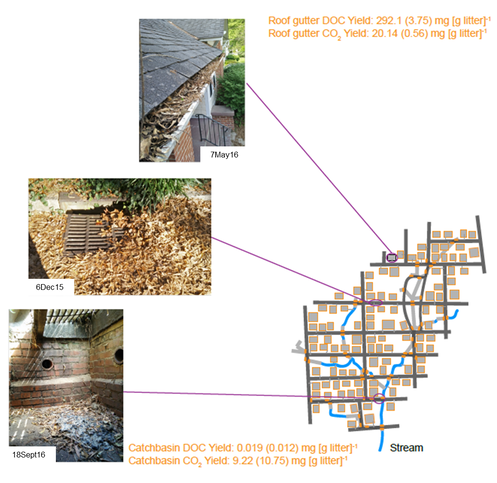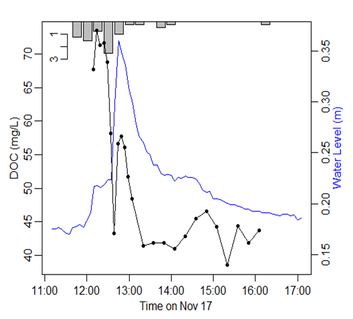Urbanization and stream ecology
Urbanization changes how water moves across the landscape, as well as the pollutants, organic matter, and nutrients it picks up on its way to a stream or pond. This drives changes in the water chemistry and temperature, habitat structure, hydrology, and biology of water bodies that drain urban landscapes. However, these changes don't preclude ecology - in fact, studying ecology of and for cities requires understanding of the complex ecological processes that take place across the urban stream continuum.
Water quality and ecology in streams across an urbanization gradient in Baltimore, MD
As a postdoctoral scientist with the Baltimore Ecosystem Study (BES), I'm working on multiple complementary efforts to synthesize the rich datasets generated through 20 years of dedicated and creative study of this urban ecosystem.
|
How does urbanization affect the patterns and loading of pharmaceuticals in Baltimore's urban streams?
Using an unprecedented dataset of weekly pharmaceutical measurements from eight stream reaches that span an exurban Baltimore County to dense, downtown Baltimore City, our research team (Emma Rosi, Jerker Fick, and A.J. Reisinger, and me) characterized the patterns and drivers of pharmaceutical transport in urban streams. This work demonstrates the striking temporal variability in pharmaceutical concentrations, providing a temporal perspective on the ecologically relevant concentrations and exposure to the complex chemical cocktails experienced by organisms in urban streams. In addition, this research gives an important peek into how aging water infrastructure can transmit pharmaceuticals to urban streams via leaking sewage. Over a year, this can amount to loads equivalent to tens of thousands of doses, with different composition than the loading from treated wastewater effluent. Fork et al. 2021. Environmental Science & Technology |
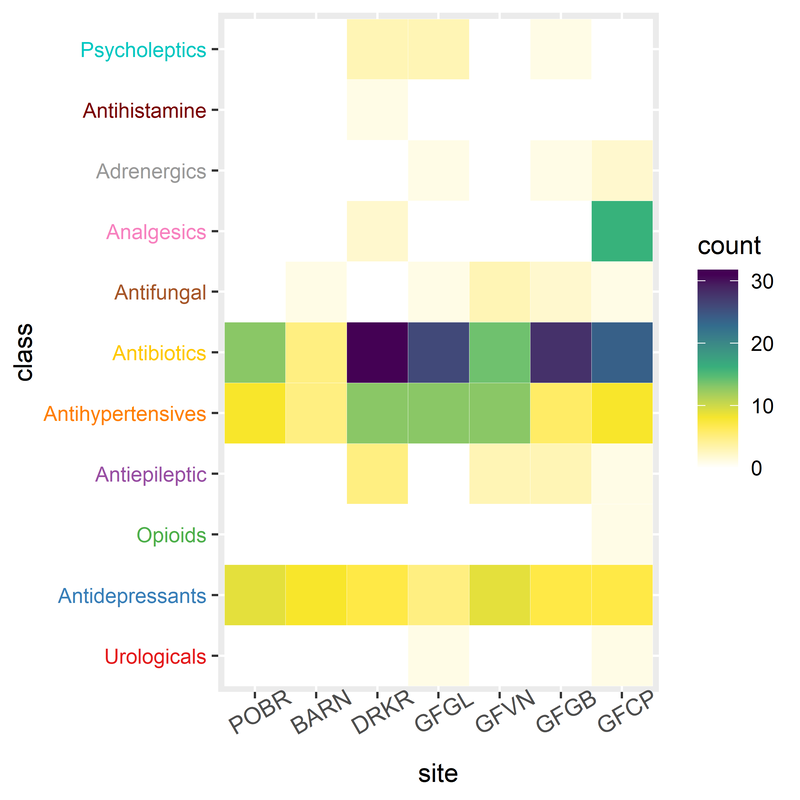
Total annual count of detections of pharmaceuticals by class in Baltimore stream sampling sites, ordered by increasing population density from left to right. Streams with higher population density in their watersheds tend to have a greater number of different pharmaceutical compounds and a higher total number of detections.
|
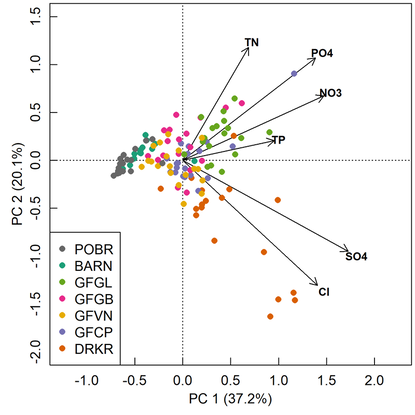
Principal component analysis of the annual ranges in solutes among BES streams. Each point represents the range in concentration of the 'chemical cocktail' for one year in one stream. Different streams are indicated by color, ordered in the legend by the percentage of their watershed covered by impervious surfaces (a common proxy for urbanization). Arrow show the loadings for the different solutes included in the analysis (in general points that fall more to the right side of the figure have greater annual ranges of solutes).
|
How does urban land cover affect the timing and concentrations of chemical mixtures in urban streams, and how have these patterns changed over time?
Working with AJ Reisinger, Emma Rosi, and Peter Groffman, I am analyzing 20 years of weekly water chemistry samples from BES streams. By simultaneously considering C-Q relationships (the relationships between individual solutes' concentrations and flow) and multi-solute patterns among seasons, I am working to uncover the mechanisms that drive patterns in nutrients and other solutes over an urban-rural gradient. Building on previous work that describes the "chemical flashiness" of urban streams, this work will bring a long-term perspective and build understanding of how urban streams change over time and under different climatic conditions. |
How do objective measurements of environmental quality compare with residents' perceptions of environmental quality?
Together with a team of other BES-affiliated scientists (including postdoctoral scientists Elsa Anderson, Dexter Locke, and Laurence Lin as well as Cary scientists Shannon La Deau, Emma Rosi, and Peter Groffman), I'm working to understand how "objective" measurements of environmental structure and condition influence how people in the city perceive their environmental quality. We are bringing together our unique spheres of expertise to link long-term records of water quality, stream geomorphology, biological communities, hydrologic parameters, and tree condition with survey data characterizing how residents of Baltimore perceive the state of and changes in the quality of their environment.
Suchy et al. in review
Together with a team of other BES-affiliated scientists (including postdoctoral scientists Elsa Anderson, Dexter Locke, and Laurence Lin as well as Cary scientists Shannon La Deau, Emma Rosi, and Peter Groffman), I'm working to understand how "objective" measurements of environmental structure and condition influence how people in the city perceive their environmental quality. We are bringing together our unique spheres of expertise to link long-term records of water quality, stream geomorphology, biological communities, hydrologic parameters, and tree condition with survey data characterizing how residents of Baltimore perceive the state of and changes in the quality of their environment.
Suchy et al. in review
Stormwater and organic matter in urban streams and headwaters
Urbanization results in changes in the sources of organic matter and the processes that transport dissolved organic matter (DOM) from the landscape to an urban stream. Together, these changes mean differences in the timing and composition of DOM in urban as compared to rural streams, with consequences for the ecological effects of urban DOM.
In urban catchments, designed and engineered structures like roofs, gutters, streets, and pipes are the ephemeral flowpaths that move runoff from the landscape to the stream. Roofs, roadside gutters, and catch basins store and process organic matter between storms. During storms, these engineered headwaters can be rapidly connected and deliver DOM and other accumulated biogeochemical products to urban streams and downstream aquatic ecosystems.
In urban catchments, designed and engineered structures like roofs, gutters, streets, and pipes are the ephemeral flowpaths that move runoff from the landscape to the stream. Roofs, roadside gutters, and catch basins store and process organic matter between storms. During storms, these engineered headwaters can be rapidly connected and deliver DOM and other accumulated biogeochemical products to urban streams and downstream aquatic ecosystems.
|
How do processing, storage, and transport of organic matter in engineered headwaters determine DOM delivery to urban streams?
Together with Duke Ecology alum Joanna Blaszczak, UNC PhD student Joseph Delesantro, and the Duke River Center's Jim Heffernan, I assessed the role of roof gutters and stormwater pipes (i.e. the engineered headwaters of urban stream networks) as proximate sources of DOM and nitrogen to urban streams during storms. We measured the annual carbon budget for roofs, conceptualizing them as small catchments nested within the catchment of an urban headwater stream. To do this, we measured rates of leaf litter input to roofs and fluxes of C out through downspouts and decomposition. We found that roofs transform nearly one third of the leaf litter they receive into DOM that leaves through the downspout, and that scaling these fluxes of DOM from roofs and catch basins can account for a large proportion of the DOM in stormflow in the stream. Fork et al. 2018. Limnology and Oceanography Letters. |
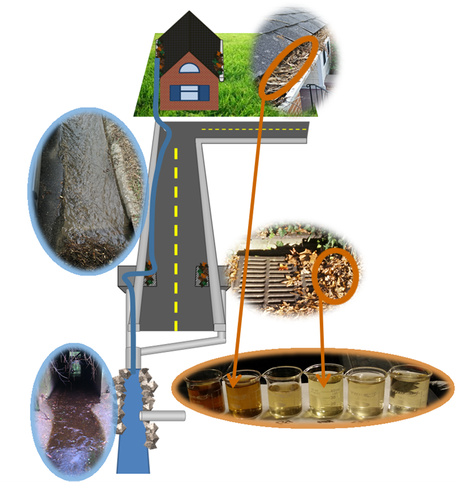
How does biodegradation shape the DOM that is generated in urban headwaters?
The engineered headwaters of urban streams can give us a uniquely accessible view into DOM generation at the aqua-terrestrial interface, since we know exactly where flowpaths will activate when the rain comes, and the organic matter that will be in contact with these ephemeral flows.
We measured how the amount and composition in leachates of potential DOM sources and headwater flows changed with biodegradation, and found that source leachates undergo a period of transient increase in the diversity of DOM with little change in DOC concentration. In other words, leachate DOM is "reorganized" through the production of transient degradation by-products before organic matter is removed from the dissolve pool. On the other hand, the DOM that flows along urban channels shows a continuous directional change in composition associated with the continuous removal of labile DOM over the course of our incubation experiment.
Fork et al. 2020. Aquatic Sciences.
The engineered headwaters of urban streams can give us a uniquely accessible view into DOM generation at the aqua-terrestrial interface, since we know exactly where flowpaths will activate when the rain comes, and the organic matter that will be in contact with these ephemeral flows.
We measured how the amount and composition in leachates of potential DOM sources and headwater flows changed with biodegradation, and found that source leachates undergo a period of transient increase in the diversity of DOM with little change in DOC concentration. In other words, leachate DOM is "reorganized" through the production of transient degradation by-products before organic matter is removed from the dissolve pool. On the other hand, the DOM that flows along urban channels shows a continuous directional change in composition associated with the continuous removal of labile DOM over the course of our incubation experiment.
Fork et al. 2020. Aquatic Sciences.
|
How does urbanization affect the composition, concentration, and timing of DOM in urban streams?
I have paired measurements of concentration, composition (using various indices based on optical measures and EEM-PARAFAC approaches) to characterize differences in DOM from stormflow across the engineered headwaters of an urban stream. DOM in the catchment we studied shows "first flush" behavior, with the peak of DOM concentration occurring before peak water level. In addition, the composition of the DOM in the first flush seems to be markedly different (smaller, more aliphatic molecules) from the DOM in the stream at the end of the storm and at baseflow. |
